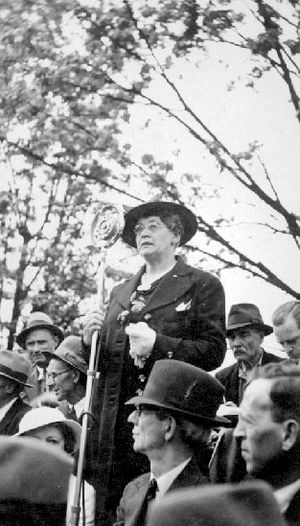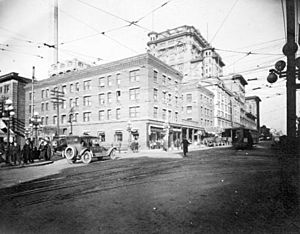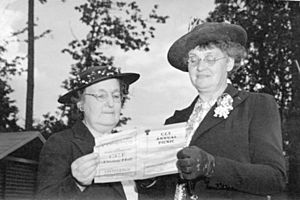Helena Gutteridge facts for kids
Helena Gutteridge (born April 8, 1879 – died October 1, 1960) was a true pioneer. She was a feminist who believed in equal rights for women. She was also a suffragist, fighting for women's right to vote. Helena was a trade union leader and made history as the first female city councillor in Vancouver, British Columbia, Canada. She worked hard to improve women's rights when gender equality was not a common idea.
Born in Battersea, London, England, Helena was the second daughter in her family. At age 14, she was stopped from continuing her education. This was due to her social class and unfair treatment because she was a girl. To keep learning, Helena left home that same year. She worked as a tailor in London from 1893 to 1911. This job helped her pay for her education. During this time, she was also very active in the women's suffrage movement in the United Kingdom. She joined the Women's Social and Political Union (WSPU). This group gave her lots of political experience and skills. These skills helped her greatly in her later career.
In September 1911, Helena moved to western Canada. She quickly joined the women's suffrage movement in Vancouver. She spent much of her time helping women who were struggling financially. In 1932, she became a member of the Co-operative Commonwealth Federation (CCF). Helena then focused on promoting socialist ideas in British Columbia. This was her way of responding to the tough times of the Great Depression. In 1937, she was elected as the first female Councillor in Vancouver. While in office, Helena made affordable housing a top priority. Most of her ideas aimed to help everyone in society. She won re-election in 1939 but lost in 1940 and 1941.
Besides her political work, Helena was also involved in social work. She helped Japanese Canadians at Lemon Creek from 1942 to 1945. Even after she retired, Helena kept working for women's rights. She is remembered for her leadership in workers' rights. She also helped advance equal pay in B.C. Her election as Vancouver's first female city councillor and her lifelong dedication to women's rights are her lasting legacy.
Contents
Early Life and Education
Helena Gutteridge grew up in a time of change in London. Her family often had to move because their neighborhood was being rebuilt. This constant moving and the tough living conditions made Helena very aware of class differences.
When Helena was born in 1879, diseases like smallpox and diarrhea were common. Many children died young. Helena lost a brother when he was just two months old. The lack of clean water and good hygiene affected her childhood.
From 1886 to 1892, Helena went to Holy Trinity Church School. She learned basic reading, writing, and math. At 13, she had to stop school. Education was mostly for rich families who could afford private schools.
Girls from working-class families often didn't get much education. Helena's family chose to pay for her brothers' schooling instead of hers. This unfair decision made Helena passionate about feminism. It shaped her lifelong fight against prejudice and unfair treatment of women.
At 14, Helena left home to support herself. She attended Regent Street Polytechnic School and the Royal Sanitary Institute. At the Royal Sanitary Institute, she earned a certificate in teaching and sanitary science. This knowledge helped her later when she became a city councillor in Vancouver.
To pay for her education, Helena worked as an apprentice in a clothing shop. She started with small tasks and worked her way up. Eventually, she became a tailor at John Lewis on Oxford Street. This was a big achievement for a woman in the 1880s. The shop provided food and a room for its workers. However, wages were very low, and workers couldn't get married. Helena worked long hours for little pay. But she understood that being financially independent was key to getting equal treatment and continuing her education. Her experiences later inspired her to fight for equal pay for men and women in British Columbia.
Personal Life
At 40, Helena married Oliver Fearn, a 26-year-old poultry farmer, in October 1919. They lived outside Vancouver in a rural area called Mount Lehman. The area didn't have electricity or running water. Helena enjoyed the peaceful farm life from 1921 to 1931. She liked the close-knit community and made good friends with other farm families.
Even in this quiet place, she stayed involved in women's rights. She even started a local branch of the Women's Institutes. Helena also joined the region's literary and debate society. She enjoyed this community life and the hard physical work.
Helena and Oliver did not have children. They divorced in 1928. Helena continued to manage the farm for a few more years. She then moved back to Vancouver in 1932.
Political Career
Fighting for Women's Vote in London
Helena's political journey began with the Women's Suffrage Movement in the United Kingdom. She joined the Women's Social and Political Union (WSPU). This group was only for women and fought for their right to vote. Their main slogan was "Votes for Women."
The WSPU taught Helena how to give powerful public speeches. She was known for her leadership and organizing skills. In 1910, Helena often gave speeches and led large marches in London. She learned a lot from leaders like Emmeline Pankhurst.
The WSPU's work had a big impact worldwide. They even sent members to Canada to help the suffrage movement there. Helena was one of these members. On September 8, 1911, she sailed to Quebec and then traveled by train to British Columbia. What was meant to be a short visit turned into a lifelong commitment to equality in B.C.
Women's Vote in British Columbia
In British Columbia, several groups worked for women's right to vote from 1910 to 1917. The Political Equality League was one of the most active. At first, their efforts were not very successful. To boost the movement, the league split into smaller groups. These included the B.C. Women Suffrage League and the Women's Freedom Union.
Helena Gutteridge founded the Women Suffrage League. This group became the most successful. Helena also started Pioneer Political Equality, which held meetings for working women. The Women Suffrage League eventually helped white women in B.C. get the right to vote in 1917. However, women of Asian and Indian descent did not get this right until after World War II.
Helena also helped women by co-founding the Women's Employment League. She also helped create the Carvell Hall Cooperative Settlement. These groups provided jobs and shelter for women in need. Helena also wrote columns for the B.C. Federationist newspaper. She was also a women's correspondent for the Labour Gazette.
Economic Security and Equal Pay
Helena also worked hard for fair wages and workers' rights. She believed that women's right to vote, joining unions, and being financially independent were all connected. In 1912, she saw how much less women were paid than men in B.C. She then joined the local Tailors' Union. Later, she became the first female member, treasurer, and secretary of the Vancouver Trades and Labour Council from 1913 to 1921. She wanted to represent women in a male-dominated field. Helena's arrival in Vancouver gave female union movements strong leadership. She helped form the Laundry Workers' Union. She was also involved in the Vancouver Laundry Workers' Strike in 1918.
Helena believed that economic equality was essential for true gender equality. She said that the ability to earn money was a strong reason for women to have the right to vote. She also felt that women organizing politically and joining unions were both necessary for women to achieve financial freedom.
After a tough economic period in 1912, conditions were especially hard for women in B.C. Women were often the first to lose their jobs. They also earned much less than men and received fewer government benefits. To help women in Vancouver, Helena organized a toy-making co-operative. She also pushed the government to provide more help for women.
The toy-making co-operative opened in October 1914, just before Christmas. This was a good time because there was a demand for toys. By November 9, 60 girls and women were making dolls and toys. They earned $3.50 a day. By Christmas, the co-operative also offered cooking and dressmaking services. More than 150 women worked there by the end of 1914. The co-operative was located at 1027 Robson Street in Vancouver. Its unused rooms also provided shelter for unemployed women.
The toy-making co-operative closed in February 1915. But it had provided jobs for almost 500 women in Vancouver. It also helped 700 women get meal tickets. At its busiest, the co-operative even had a retail store at 700 Granville Street. Even though it was short-lived, the co-operative was a big success. It helped many women in Vancouver during a difficult time.
Helena continued to fight for economic security and equality for women. She campaigned to include equal pay for women and men in the Vancouver Trades and Labor Council's rules. In 1917, she started the Minimum Wage League. This group successfully helped pass the Minimum Wage Bill for Women in 1918.
Working with the Co-operative Commonwealth Federation
On August 1, 1932, the Co-operative Commonwealth Federation (CCF) was formed in Calgary, Alberta. The CCF was a political group of farmers, socialists, and labor groups. They wanted economic changes to deal with the problems of the Great Depression. Canada was hit hard by the global financial crisis.
In the same year, Helena returned to Vancouver. Many people in Vancouver were unemployed in June 1932. Poverty, lack of proper city services, and a rise in homeless people led to a call for political action.
The CCF believed in economic reforms. Their socialist ideas matched Helena's own beliefs. Helena joined the movement with other progressive women like Dorothy Steeves. She worked hard for the CCF's goals until 1942.
Helena started by helping to get subscriptions for The Commonwealth. This was the CCF's official newspaper. In 1933, she worked on the provincial election campaign. Helena often spoke in crowded living rooms to people eager to learn about the new socialist movement. The CCF's campaign quickly gained support. Seven of its members were elected in B.C. The CCF became the main opposition party to the newly elected Liberal Party.
Helena spent her early years in the CCF focusing on unemployment. She worked with other party leaders like Harold Winch. They set up the CCF Unemployment Conference in 1934. This conference aimed to organize unemployed people and get more financial help from the government. However, the conference did not succeed in changing the provincial economy much. Helena left the conference in late 1935. She joined the CCF's Planning Commission. There, she became a key person in planning a new socialist society.
Helena was not just a party leader. She was a dedicated socialist who wanted to improve B.C.'s economy. She wrote that the CCF was part of a worldwide movement. This movement believed that working together would replace competition. It would also bring security and plenty instead of poverty.
Election to City Council
In 1937, Helena Gutteridge became the first woman elected to Vancouver City Council. While in office, Helena continued to fight for women's rights. She strongly opposed a plan to stop hiring married women whose husbands worked. This plan was meant to reduce unemployment. She also spoke out against unfair policies based on race. She supported giving the right to vote to racial minorities who had lived in B.C. for at least 12 months.
One of Helena's biggest achievements was pushing for social housing in B.C. In the 1930s, Vancouver faced a shortage of affordable homes. Helena believed that government-funded housing was the best solution. Other city councillors were hesitant to spend more government money. The city also had to fund housing for soldiers returning from war. They also had to take over mortgages from homeowners who couldn't pay.
Despite strong objections, Helena succeeded in forming the Housing Committee. This committee created a detailed housing plan for Vancouver. She also chaired Vancouver's Town Planning and Parks Committee. Her main focus was government-subsidized social housing. Even though a government housing policy wasn't fully put in place during her time, Helena Gutteridge laid a strong foundation. This led to B.C.'s social housing policies being implemented in the 1950s.
Leaving the Political Scene
The CCF lost the provincial by-election in December 1939. Both Helena and her running mate Alfred Hurry were defeated. Some people blamed Helena's defeat on her refusal to let Vancouver pay for the visit of King George VI and Queen Elizabeth. She felt the city should spend money on the poor and unemployed, not on entertaining royals. Helena ran for re-election again in 1940 and 1941, but she did not win either time.
With no more council duties, Helena focused all her energy on the CCF. She chaired the Organization Committee and served as a provincial executive. In 1942, she decided to move to Lemon Creek to work as a Social Worker.
Social Work Career
After the Japanese attack on Pearl Harbor in December 1941, Canada declared war on Japan. This led to strong anti-Japanese feelings in B.C. Many people threatened to riot if the Japanese population was not removed from the coast. The government did little to calm these fears.
On January 16, 1942, the Canadian government used the War Measures Act. They created "protected areas" where Japanese nationals and Japanese Canadians were not allowed. About 21,000 Japanese people were forced to leave their homes. They were moved to places like Lemon Creek.
Helena became a welfare worker in Lemon Creek for the Japanese population. By 1942, she was no longer a main decision-maker in the CCF. She needed to earn a living. So, she welcomed the chance to help the Japanese population.
Helena worked as a social worker in Lemon Creek from 1942 to the spring of 1945. Many residents of Lemon Creek remembered her fondly. She helped families with their daily problems. She was truly dedicated to improving their lives.
Legacy
In 2017, Joyce Murray, a Member of Parliament for Vancouver Quadra, honored Helena Gutteridge. On behalf of the Canadian government, Murray declared Helena Gutteridge a national historic person. A special plaque was placed at Vancouver City Hall to mark her legacy.
Joyce Murray said she was proud to honor Helena. She called Helena a "visionary reformer." She noted that Helena represented female workers in unions. She also helped organize unions for women. Helena built connections between feminist and labor groups. Murray said it was important to learn about people like Helena who shaped Canada's history.
Gregor Robertson, the Mayor of Vancouver at the time, also spoke. He said Helena's work laid important groundwork for issues still relevant today. These include gender equality, equal pay, homelessness, and affordable housing. He said celebrating Helena's memory reminds us to keep working for social and political change.
The Helena Gutteridge Plaza was named in her honor on International Women's Day in 2018. The plaza celebrates Helena's achievements and her commitment to women's right to vote in British Columbia. On March 8, city officials and community leaders unveiled the plaza sign.
Mayor Robertson commented that the day was not just about honoring Helena. It was also about setting intentions for the future. He noted that her work for justice and equality still has a long way to go.
Elizabeth Ball, a city councillor, found Helena's achievements inspiring. She said Helena's push against prejudice and her work for diverse people inspired her. Ball studied Helena's background when she planned to enter politics.
The plaza is located at Yukon Street and 11th Avenue. It is on the north side of Vancouver City Hall. The plaza is a public space for community activities and events. Residents can use the space to organize events by getting a special permit from the City.
Retirement and Death
In 1947, Helena moved into the home of Hilda and Denny Kristiansen in Vancouver. She lived there for the rest of her life. Even in retirement, Helena remained interested in women's rights. She continued to be politically active. She joined the CCF Provincial Council for Women. Later, she became a member of the Women's International League for Peace and Freedom. In 1957, at 78, she still chaired occasional meetings for the Town Planning Commission in Vancouver.
Helena Gutteridge died of pancreatic cancer on October 1, 1960. She was 79 years old. Her memorial service was held at the chapel of Mount Pleasant Funeral Home in Vancouver.







